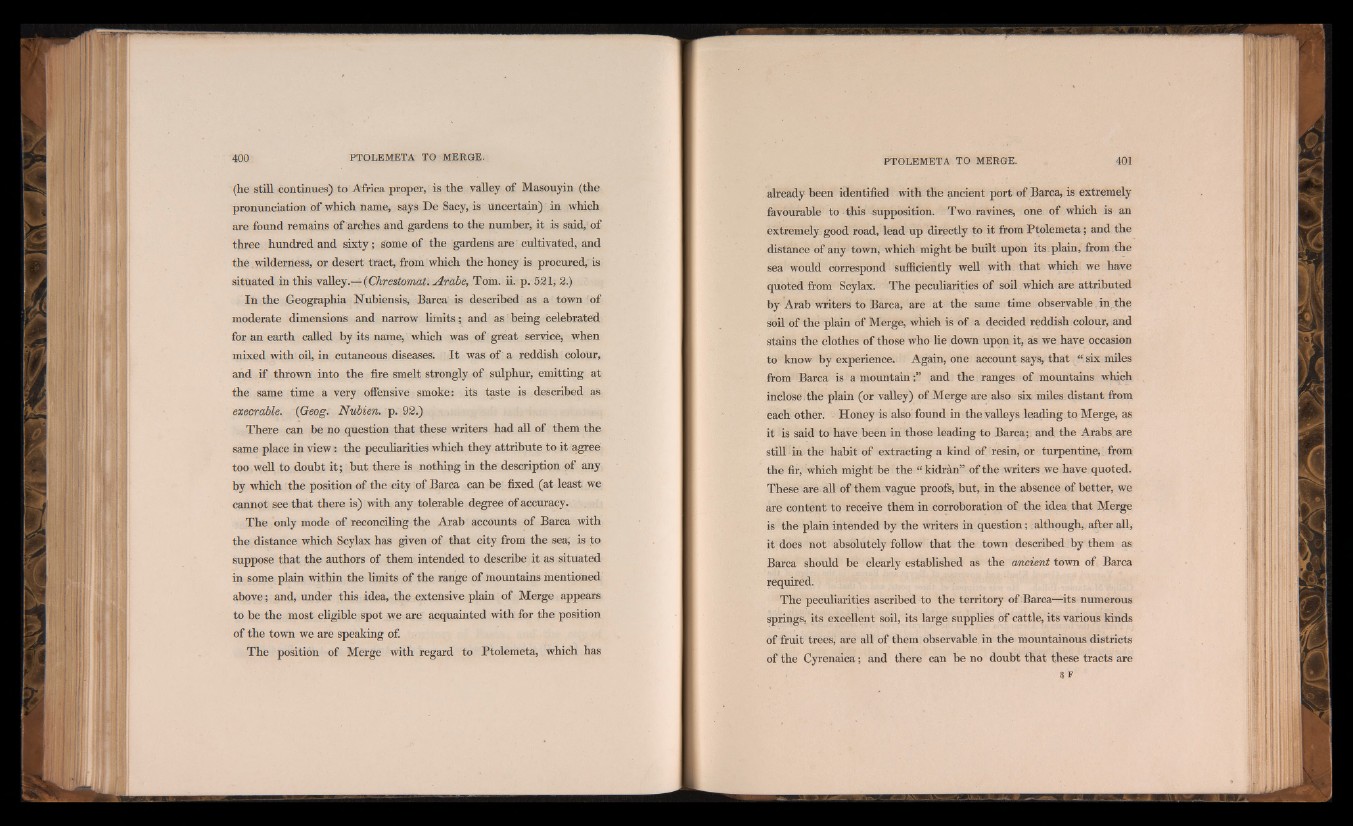
(he still continues) to Africa proper, is the valley of Masouyin (the
pronunciation of which name, says De Sacy, is uncertain) in which
are found remains of arches and gardens to the number, it is said, of
three hundred and sixty; some of the gardens are cultivated, and
the wilderness, or desert tract, from which the honey is procured, is
situated in this valley|nr (Ckrestomat. Arabe, Tom. ii. p. 521, 2.)
In the Geographia Nubiensis, Barca is described as a town of
moderate dimensions and narrow limits; and as being celebrated
for an earth called by its name, which was of great service, when
mixed with oil, in cutaneous diseases. I t was of' a reddish colour,
and if thrown into the fire smelt strongly of sulphur, emitting at
the same time a very offensive smoke: its taste is described as
execrable. (Geog. Nubien. p. 92.)
There can be no question that these writers had all of them the
same place in view: the peculiarities which they attribute to it agree
too well to doubt it; but there is nothing in the description of any
by which the position of the city of Barca can be fixed (at least we
cannot see that there is) with any tolerable degree of accuracy.
The only mode of reconciling the Arab accounts of Barca with
the distance which Scylax has given of that city from the sea, is to
suppose that the authors of them intended to describe it as situated
in some plain within the limits of the range of mountains mentioned
above; and, under this idea, the extensive plain of Merge appears
to he the most eligible spot we are acquainted with for the position
of the town we are speaking of.
The position of Merge with regard to Ptolemeta, which has
already been identified with the ancient port of Barca, is extremely
favourable to this supposition. Two. ravines, one of which is an
extremely good road, lead up directly to it from Ptolemeta; and the
distance of any town, which might be built upon its plain, from the
sea would correspond sufficiently well with that which we have
quoted from Scylax. The peculiarities of soil which are attributed
by Arab writers to Barca, are at the same time observable, in the
soil of the plain of Merge, which is of a decided reddish colour, and
stains the clothes of those who lie down upon it, as we.have occasion
to know by experience. Again, one account says, that “ six miles
from Barca is a mountain;” and the ranges of mountains which
inclose , the plain (or valley) of Merge are also six miles distant from
each other. Honey is also! found in the valleys leading to Merge, as
it is said to have been in those leading to Barca; and the Arabs are
still in the habit of extracting a kind of resin, or turpentine, from
the fir, which might be the “ kidran” of the writers we have quoted.
These are all of them vague proofs, but, in the absence of better, we
are content to receive them in corroboration of the idea that Merge
is the plain intended by the writers in question; although,, after all,
it does not absolutely follow that the town described by them as
Barca should be clearly established as the ancient town of Barca
required.
The peculiarities ascribed to the territory of Barca—its numerous
springs, its excellent soil, its large supplies of cattle, its various kinds
of fruit trees, are all of them observable, in the mountainous districts
of the Cyrenaica; and there can be no doubt that these tracts are
8 p